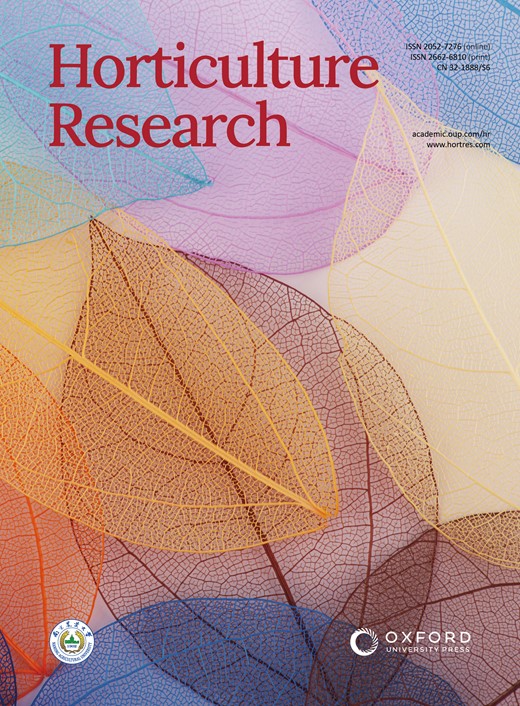由质体结构变异引起的叶片变色:以塔斯马尼亚石竹(Dianella tasmanica)为例
IF 8.7
1区 农林科学
Q1 Agricultural and Biological Sciences
引用次数: 0
摘要
摘要 变色植物通常由于其白化部分的单核苷酸突变或小的插入/缺失而表现出质体异构现象。然而,我们在这里发现了变色植物 Dianella tasmanica(天南星科)白化部分的质体结构变异。这种结构变异是由大单体拷贝区(LSC)中一个侧翼为 92 bp 的片段的 11 bp 倒位重复所介导的分子间重组引起的,它产生了一个巨大的质体(228878 bp),具有陆生植物中已知最大的 105226 bp 倒位重复(IR)和最小的 92 bp LSC。它还在 LSC 边界上产生了约 7 kb 的缺失,从而消除了三个蛋白质编码基因(psbA、matK 和 rps16)和一个 tRNA 基因(trnK)。许多质体基因的表达发生了巨大变化,包括 psbA、matK 和 rps16 的表达几乎可以忽略不计,光合作用相关基因的表达减少,而翻译装置相关基因的表达增加。显微镜和超微结构观察结果表明,变异个体的绿色部分和白化部分都存在白化组织,变异个体白化组织的叶肉细胞中叶绿体发育不良。这些发育不良的叶绿体很可能携带着巨大且重新排列的质体,这很可能是叶缘失去光合作用和白化的原因。考虑到短重复在植物质体中比较常见,而且白化部分不需要光合作用,因此这种结构变异在变异植物的质体中可能并不罕见。本文章由计算机程序翻译,如有差异,请以英文原文为准。
Leaf variegation caused by plastome structural variation: an example from Dianella tasmanica
Summary Variegated plants often exhibit plastomic heteroplasmy due to single nucleotide mutations or small insertions/deletions in their albino sectors. Here, however, we identified a plastome structural variation in albino sectors of the variegated plant Dianella tasmanica (Asphodelaceae), a perennial herbaceous plant widely cultivated as an ornamental in tropical Asia. This structural variation, caused by intermolecular recombination mediated by an 11-bp inverted repeat flanking a 92 bp segment in the large single copy region (LSC), generates a giant plastome (228,878 bp) with the largest inverted repeat (IR) of 105,226 bp and the smallest LSC of 92 bp known in land plants. It also generates a ~7 kb deletion on the boundary of LSC, which eliminates three protein coding genes (psbA, matK and rps16) and one tRNA gene (trnK). Albino sectors exhibit dramatic changes in expression of many plastid genes, including negligible expression of psbA, matK and rps16, reduced expression of photosynthesis-related genes, and increased expression of genes related to the translational apparatus. Microscopic and ultrastructure observations showed that albino tissues were present in both green and albino sectors of the variegated individuals, and chloroplasts were poorly developed in the mesophyll cells of the albino tissues of the variegated individuals. These poorly developed chloroplasts likely carry the large and rearranged plastome, which is likely responsible for the loss of photosynthesis and albinism in the leaf margins. Considering that short repeats are relatively common in plant plastomes, and that photosynthesis is not necessary for albino sectors, structural variation of this kind may not be rare in the plastomes of variegated plants.
求助全文
通过发布文献求助,成功后即可免费获取论文全文。
去求助
来源期刊

Horticulture Research
Biochemistry, Genetics and Molecular Biology-Biochemistry
CiteScore
11.20
自引率
6.90%
发文量
367
审稿时长
20 weeks
期刊介绍:
Horticulture Research, an open access journal affiliated with Nanjing Agricultural University, has achieved the prestigious ranking of number one in the Horticulture category of the Journal Citation Reports ™ from Clarivate, 2022. As a leading publication in the field, the journal is dedicated to disseminating original research articles, comprehensive reviews, insightful perspectives, thought-provoking comments, and valuable correspondence articles and letters to the editor. Its scope encompasses all vital aspects of horticultural plants and disciplines, such as biotechnology, breeding, cellular and molecular biology, evolution, genetics, inter-species interactions, physiology, and the origination and domestication of crops.
 求助内容:
求助内容: 应助结果提醒方式:
应助结果提醒方式:


